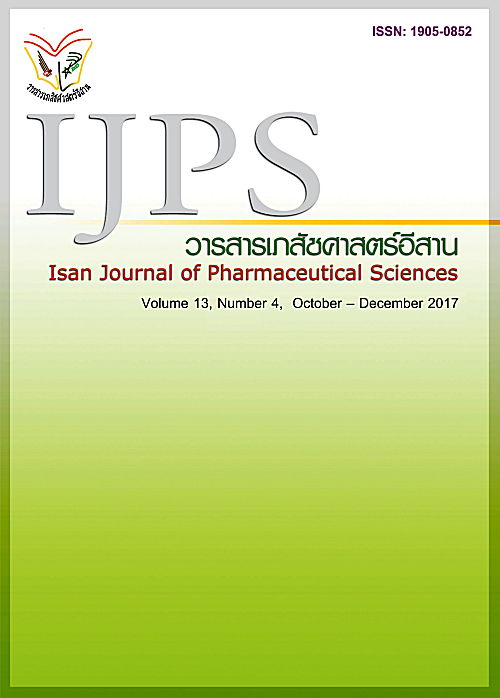Steviol stimulates proteasomal-mediated β-catenin degradation in Madin-Darby canine kidney cells
Main Article Content
Abstract
Cystogenesis in autosomal dominant polycystic kidney disease (ADPKD) involved cAMP-stimulated epithelial cell proliferation to form the cyst-ling cell. Our previous study showed that steviol at a concentration of 100 µM reversibly inhibited MDCK cyst growth by 38.3% without any effect on cytotoxicity. In addition, steviol suppressed cell proliferation through the inhibition of mTOR/S6K signaling in PKD mouse model. However, the mechanisms of steviol on cell proliferation pathway have not been evaluated in MDCK cells. This study was aimed to investigate detailed mechanisms of steviol on cell proliferation to slow MDCK cyst growth. Method: Western blot analysis was performed. Results: Steviol at a concentration of 100 µM reduced phosphorylation of extracellular signal-regulated kinase 1/2 (ERK1/2) by 45-50% at 6 and 24 h of incubation in MDCK cell monolayers. Steviol also inhibited β-catenin expression by 34-41% at 6 and 24 h of incubation. Interestingly, steviol also suppressed phosphorylation of glycogen synthase kinase-3 beta (GSK-3β), an activated protein for inducing β-catenin accumulation in cytosol. In addition, treatment with 50 µM MG-132, a proteasome inhibitor, significantly abolished the effect of steviol on β-catenin expression. Conclusion: These findings suggested that steviol retarded MDCK cyst enlargement, in part, by reducing cell proliferation through the promotion of proteasome induced β-catenin degradation and ERK1/2 signaling pathways. Steviol represented a promising natural plant-based drug candidate for polycystic kidney disease.
Article Details
In the case that some parts are used by others The author must Confirm that obtaining permission to use some of the original authors. And must attach evidence That the permission has been included
References
Belibi FA, Reif G, Wallace DP, et al. Cyclic AMP promotes growth and secretion in human polycystic kidney epithelial cells. Kidney Int. 2004; 66(3):964-73.
Buchholz B, Teschemacher B, Schley G, et al. Formation of cysts by principal-like MDCK cells depends on the synergy of cAMP- and ATP-mediated fluid secretion. J Mol Med (Berl). 2011; 89(3):251-61.
Chatsudthipong V, Muanprasat C. Stevioside and related compounds: therapeutic benefits beyond sweetness. Pharmacol Ther. 2009; 121(1):41-54.
Fedeles SV, Gallagher AR, Somlo S. Polycystin-1: a master regulator of intersecting cystic pathways. Trends Mol Med. 2014; 20(5):251-60.
Foy RL, Chitalia VC, Panchenko MV, et al. Polycystin-1 regulates the stability and ubiquitination of transcription factor Jade-1. Hum Mol Genet. 2012; 21(26):5456-71.
Hwang VJ, Zhou X, Chen X, et al. Anticystogenic activity of a small molecule PAK4 inhibitor may be a novel treatment for autosomal dominant polycystic kidney disease. Kidney Int. 2017; 92(4):922-33.
Igarashi P, Somlo S. Genetics and pathogenesis of polycystic kidney disease. J Am Soc Nephrol. 2002; 13(9):2384-98.
Joly D, Ishibe S, Nickel C, et al. The polycystin 1-C-terminal fragment stimulates ERK-dependent spreading of renal epithelial cells. J Biol Chem. 2006; 281(36):26329-39.
Lal M, Song X, Pluznick JL, et al. Polycystin-1 C-terminal tail associates with beta-catenin and inhibits canonical Wnt signaling. Hum Mol Genet. 2008; 17(20):3105-17.
Lancaster MA, Gleeson JG. Cystic kidney disease: the role of Wnt signaling. Trends Mol Med. 2010; 16(8):349-60.
Lin SJ, Su TC, Chu CN, et al. Synthesis of C-4-Substituted Steviol Derivatives and Their Inhibitory Effects against Hepatitis B Virus. J Nat Prod. 2016; 79(12):3057-64.
Shibazaki S, Yu Z, Nishio S, et al. Cyst formation and activation of the extracellular regulated kinase pathway after kidney specific inactivation of Pkd1. Hum Mol Genet. 2008; 17(11):1505-16.
Shillingford JM, Murcia NS, Larson CH, et al. The mTOR pathway is regulated by polycystin-1, and its inhibition reverses renal cystogenesis in polycystic kidney disease. Proc Natl Acad Sci U S A. 2006; 103(14):5466-71.
Torres VE, Harris PC. Polycystic kidney disease: genes, proteins, animal models, disease mechanisms and therapeutic opportunities. J Intern Med. 2007; 261(1):17-31.
Turner CM, King BF, Srai KS, et al. Antagonism of endogenous putative P2Y receptors reduces the growth of MDCK-derived cysts cultured in vitro. Am J Physiol Renal Physiol. 2007; 292(1):F15-25.
Wallace DP. Cyclic AMP-mediated cyst expansion. Biochim Biophys Acta. 2011; 1812(10):1291-300.
Wu D, Pan W. GSK3: a multifaceted kinase in Wnt signaling. Trends Biochem Sci. 2010; 35(3):161-8.
Yamaguchi T, Pelling JC, Ramaswamy NT, et al. cAMP stimulates the in vitro proliferation of renal cyst epithelial cells by activating the extracellular signal-regulated kinase pathway. Kidney Int. 2000; 57(4):1460-71.
Yamaguchi T, Wallace DP, Magenheimer BS, et al. Calcium restriction allows cAMP activation of the B-Raf/ERK pathway, switching cells to a cAMP-dependent growth-stimulated phenotype. J Biol Chem. 2004; 279(39):40419-30.
Yuajit C, Homvisasevongsa S, Chatsudthipong L, et al. Steviol reduces MDCK Cyst formation and growth by inhibiting CFTR channel activity and promoting proteasome-mediated CFTR degradation. PLoS One. 2013; 8(3):e58871.
Yuajit C, Muanprasat C, Gallagher AR, et al. Steviol retards renal cyst growth through reduction of CFTR expression and inhibition of epithelial cell proliferation in a mouse model of polycystic kidney disease. Biochem Pharmacol. 2014; 88(3):412-21.
Yuajit C, Muanprasat C, Homvisasevongsa S, et al. Steviol stabilizes polycystin 1 expression and promotes lysosomal degradation of CFTR and beta-catenin proteins in renal epithelial cells. Biomed Pharmacother. 2017; 94:820-6.


